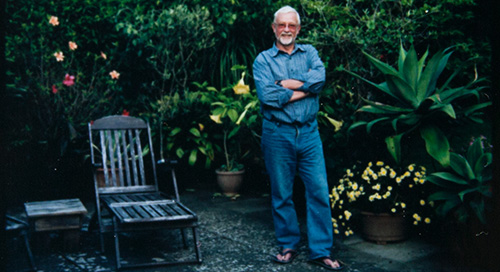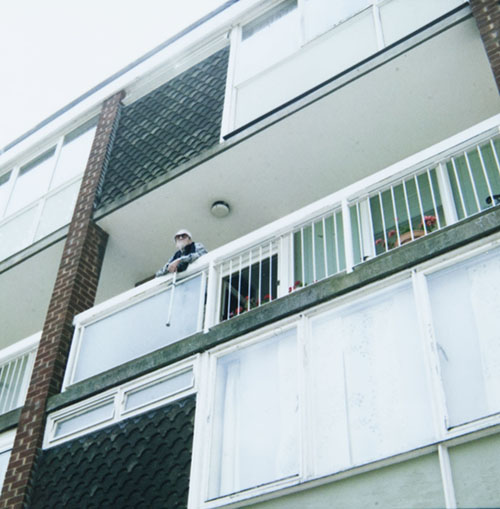Is happiness homemade?

Libby Burton spoke to Gareth Jenkins as part of the What Makes Us Happy series, following conversations with Sarah Stewart-Brown, Claire Haworth and Andrew Oswald and Eugenio Proto.
 Elizabeth ‘Libby’ Burton was the Professor of Sustainable Building Design and Wellbeing at the University of Warwick, working in both the School of Engineering and Warwick Medical School. Originally a qualified architect, Libby was frustrated by an industry that encouraged her to look solely at the aesthetics of a building rather than how it would make people feel. She moved into research and her work investigated the social aspects of sustainability and how the built environment (architecture and urban design) influences our wellbeing, quality of life and mental health.
Elizabeth ‘Libby’ Burton was the Professor of Sustainable Building Design and Wellbeing at the University of Warwick, working in both the School of Engineering and Warwick Medical School. Originally a qualified architect, Libby was frustrated by an industry that encouraged her to look solely at the aesthetics of a building rather than how it would make people feel. She moved into research and her work investigated the social aspects of sustainability and how the built environment (architecture and urban design) influences our wellbeing, quality of life and mental health. After being diagnosed with cancer, she wanted to talk about how she brought together her own pursuit of happiness and her twin passions for the built environment and a desire to make a difference to the world, to bring happiness to people’s lives and to make their lives better. Sadly, Libby passed away in November 2014.
Q) How does the world around us, the architecture and urban landscape, affect our wellbeing and mental health?
We all have our favourite spaces and places. Where do you like to go on holiday? Where do you like to sit and relax in your home? We know that some places make us feel happy and uplifted while others make us feel decidedly less so. So, what makes the difference? What is it about our favourite places that make them so appealing? This is what I have spent the last 15 years investigating, in my research unit, WISE (Wellbeing in Sustainable Environments). I’m interested not just in what makes us feel instantly happy, but what is good for us in the long run – what places help us to flourish as people.
We need much more research but, from the evidence we do have, it seems there are environments that support people’s wellbeing better than others.
 Q) So, buildings should be more than just functional structures?
Q) So, buildings should be more than just functional structures?
For sure. Buildings and places should be attractive. I have a feeling that whether or not an environment is ugly or attractive affects our wellbeing greatly, but very little research has been carried out on this, probably because attractiveness is so difficult to define and measure. During the Renaissance it was thought that beauty in buildings stemmed from their proportions. Maybe there is truth in that. I wonder, too, if beauty stems from having depth in facades, human-scale details, using natural materials, incorporating greenery and from drawing on images that have positive associations. More research is needed though.
Q) Most people, I think, will be familiar with the concept of population density but there’s also research into urban density – with the urban sprawl of some American cities at one end versus the more ‘compact’ cities and towns of Europe at the other. Does the extent of our urban areas play into our state of happiness?
There has been a lot of debate about ideal densities of development. What appears to work well, in the UK at least, is a relatively high density of development. This encourages a number of things including walking or cycling and physical activity has been shown to be good for wellbeing. Where possible in residential areas, it is beneficial to incorporate local facilities and amenities – shops, cafes, pubs, bus stops, GP surgeries and so on. This encourages walking as well as social interaction. Relatively high densities are also required to ensure the viability of local public transport and amenities.
Q) Are there any downsides to more compact densities?
It can be too compact and there is a balance to be struck. High-rise housing appears to be detrimental for wellbeing so it is best to aim for medium to low-rise development, such as semi-detached and terraced houses. It is also wise to ensure very good sound insulation in buildings to avoid noise nuisance from neighbours.
Q) I was watching an old TED talk by Kamal Meattle recently and he was advocating the use of plants to improve the indoor air quality at the New Delhi business park where he works. It was really interesting and I was wondering if I should be adding a bit more greenery to my home.
Natural elements in the built environment help people recover from stress and mental fatigue and generally lift their mood
I can be confident in recommending that as much greenery as possible be integrated within urban areas and not just your home; even in high-density areas it is possible to include green balconies, streets trees, grass verges, roof terraces and ‘living walls’.
Natural elements in the built environment help people recover from stress and mental fatigue and generally lift their mood. Parks and recreation grounds should be provided but attention also needs to be paid to the maintenance and quality of these spaces.
Again, there is a balance though. During the 1960s, the modernists wanted to make the whole city a park, with buildings raised up on columns. We know that this doesn’t work well; spaces need to be clearly defined and it should be obvious whether they are private, public or semi-private/semi-public so that people can take ‘ownership’ and use those spaces appropriately.
 Q) You mentioned that a reasonably dense layout works well, at least in the UK – is there anything more urban planners can do besides keeping our urban areas compact?
Q) You mentioned that a reasonably dense layout works well, at least in the UK – is there anything more urban planners can do besides keeping our urban areas compact?
Yes. The layouts of our streets is a factor and research suggests that an irregular grid is the ideal. A regular grid can create a monotonous environment but a grid is still helpful. A grid layout gives us choices and makes identifying the shortest route from A to B simple; this, in turn, encourages walking, which, as I’ve said, has been shown to be good for wellbeing. We are also more likely to know your neighbours on a curved street; the more front doors we can see from the front of our home, the wider our social network tends to be.
Another reason to favour an irregular grid pattern is to support people with dementia. I have particular expertise in ageing research, including dementia-friendly design, and it’s been found that people with dementia tend to become lost at crossroads so I think it’s best to avoid them. They also tend to lose their concentration on long, straight roads with little variety in urban form.
Staggering junctions, creating T junctions and making the streets gently winding, so the view gradually opens up in front of people, keeps a pedestrian’s interest. This helps people with dementia maintain their concentration and remember what they are doing and where they are going.
Q) At a smaller scale, is there anything about our own homes that we can look at – or that home builders should consider when building new homes?
I found in my research that people living in housing with small front gardens tended to report greater community spirit. The front garden space sets houses back from the street, therefore protecting privacy. At the same time, it is a space within which people can chat to neighbours.
It is highly beneficial to incorporate, where possible, ‘soft edges’ or transition zones in the built environment. Soft edges are buffers between the private space inside our homes and the public realm of the street. They are spaces in which we can linger, where we can interact with our neighbours or simply sit and watch the world go by.
 Q) What about inside the home?
Q) What about inside the home?
When it comes to the design of our interiors, I would not advocate open plan living, at least not for families; individual spaces are needed for different activities to take place without causing friction.
It helps if the more private rooms (the living room and bedrooms) are located at the back of the house, away from the street. I would also recommend kitchen-dining rooms rather than living-dining rooms as these make it more likely that you’ll eat together around a table and this is likely to be positive for family life and relationships.
Q) Anything else?
Always, always, maximise daylight! In some ways, we have lost the art of using daylight. The Victorians were brilliant at it. So many of the features from Victorian housing are related to effectively using daylight. The kitchen extension, for example, was to allow light into the depth of the house.
It is also essential to design homes that are easy to keep warm in the colder months. Cold housing affects not just our physical health but also our mental wellbeing. Being cold makes us tense and irritable. We also use more of a house when it is warm; if only one or two rooms are warm, the house becomes, in effect, overcrowded as people flock to those rooms. Of course, the same house may also need to be kept cool in the summer months, which can be tricky.
Q) What should the research be looking at next?
We need to know more about how our environments affect our wellbeing. We need more, better-quality research. But more than that, we need our evidence to be used and adopted in practice. Environments are being changed and created all the time. Let’s take the opportunity to ensure these environments are ones that make us happy and help us to flourish, now and in the future.
Professor Libby Burton's Legacy Lecture: The Pursuit of Happiness
More articles in this series:
Can we measure happiness? Sarah Stewart Brown, Warwick Medical School
There's something about the Danish Andrew Oswald and Eugenio Proto, Department of Economics
Is happiness in our genes? Claire Haworth, Department of Psychology
Images by Paul Daly, University of Warwick
Published
October 2014
Terms for republishing
The text in this article is licensed under a Creative Commons Attribution 4.0 International License (CC BY 4.0).
Share

